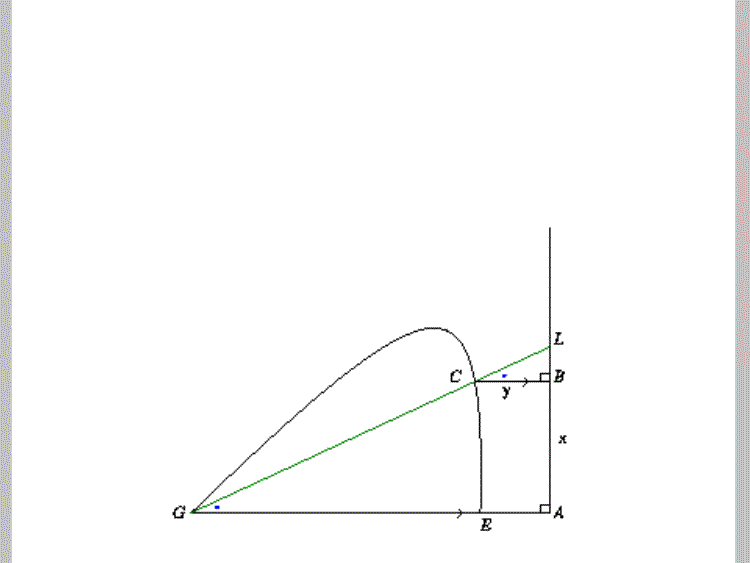

|
We want to know what degree this curve is.
|

|
This was the picture originally shown in La géométrie. Choose an arbitrary straight line KA and fix the ruler (green) at G and place it at an arbitrary point L. |
The same equation will result using any point L. To see a slide show of this, click on the link below. You need ghostview to open this.

|
First, fix the ruler at the point L. Then construct a line parallel to GA at the point C. This creates the line CB with a length of y. |

|
Now, connect C and K and construct NL to be parallel to CB and GA. |

|
Zooming in on triangle CBK, we can see that triangle CBK is similar to triangle NLK since all three angles are equal. Thus, all the sides are proportional. So c/b = y/BK, making BK = yb/c |
To see a proof on similar triangles, click on the link below. This proof is by David Hilbert (1862-1943).
Again, you need ghostview to open it.

|
Therefore, BL = yb/c - b |

|
BK = yb/c BL = yb/c - b AK = x + yb/c - b |

|
Triangle GAL is similar to triangle CBL since all three angles are equal.
|

|
y/(yb/c - b) = a/(x +
yb/c - b) y(x + yb/c - b) = a(yb/c - b) yx + y2b/c - yb = yab/c -ab y2b/c = yab/c - ab + yb - yx y2 = ya - ac + yc - yxc/b Since the highest degree is two, this curve is a conic section. In fact, it is a hyperbola. |
Now that we know it's a hyperbola, the next problem that we want to address are the asymptotes.
Descartes ended his proof here without addressing this problem.
This next construction and proof is by Van Schooten.

|
From the slide show, we saw that EA = NL. Thus, EA = c and GA = a. |

|
Extend AG to make a point D with DG = EA. Then DG = NL = c. |

|
Draw DF parallel to KC. Claim: DF and AF are the asymptotes to the hyperbola GCE. |

|
Proof: Extend BC to intersect DF at I. |

|
Draw DH parallel to AF intersecting BC at H. Triangle NKL is similar to triangle IDH since all three angles are equal. |

|
Thus, KL/LN = DH/HI DH = AB = x, KL = b, and LN = c. Therefore b/c = x/HI, so HI = cx/b Since HB = DA, HB = c + a Therefore IB = a + c - cx/b and IC = a + c - cx/b - y (IC)(BC) = (DE)(EA), a property of a hyperbola with respect to the distances between it and its asymptotes. Thus, (a + c - cx/b - y)y = ac or y2 = cy - cxy/b + ay - ac, which is the same equation as before. Therefore, AF and DF are the asymptotes to the hyperbola GCE. |